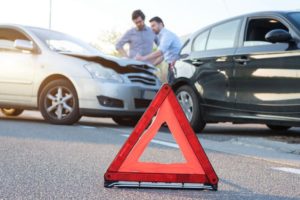Content Reviewed by:
Tucker Clagett •
June.29.2025
Vertified Content
Jun 29, 2025
| Read Time: 8 minutes

If a crash injures you or a loved one, the law determines whether you can pursue a claim, identifies who holds legal responsibility, and impacts the amount you may recover. That’s why saying the wrong thing, whether to another driver or an insurance adjuster, in the early stages of your case could seriously hurt your chances of recovering full compensation.
Before you sign anything or speak to the insurance company, take five minutes to understand how Maryland personal injury laws work and how to protect your rights. You should see our Free Legal Guide to Car Accident Cases in Maryland for all the details.
And then call a Waldorf Maryland personal injury lawyer for a free consultation.
Article Contents
Fault in Maryland: No Middle Ground

Very few states follow this rule. Most allow injured people to receive partial compensation even when they are partly at fault in a car accident. Maryland does not. One minor mistake, one distracted second, or one technical violation can cost you the entire case.
Here are some examples of shared fault situations that can put your chances of recovering compensation at risk:
- You’re driving ten mph over the speed limit, and another driver merges without checking their blind spot. You were still speeding and could be held to be partially at fault;
- Your high mounted brake light (the one in the middle of your rear window) is out, and someone rear-ends you; and
- You change lanes just a little bit outside the lines, and a speeding car slams into you.
Under Maryland law, any amount of fault on your part can be enough for the insurance company to deny your claim altogether. This is one of the strictest auto accident laws in the country, and insurance companies know it. Even when it seems obvious the other driver was reckless, insurers will search for any reason to blame you. Because if they can assign even the smallest share of fault to you, your right to compensation may be gone.
After a crash, the rules can feel confusing and overwhelming. Understanding how things work can bring clarity, protect your rights, and help you move forward with confidence and peace of mind.
GET HELP HERE
Time Limits for Filing Your Car Accident Injury Case

This timeframe covers both personal injury and property damage claims. If the accident caused a death and a surviving family member wants to file a wrongful death case, the same deadline typically applies.
Miss the deadline, and the court will likely dismiss your case, no matter how serious your injuries are or how much you’ve spent on treatment. Even the strongest evidence won’t matter if you wait too long to act.
Maryland Requires Drivers to Carry Insurance—But It Might Not Be Enough
Maryland law sets the minimum insurance coverage drivers must carry to register and operate a vehicle. The minimum limits are:
- $30,000 for bodily injury per person,
- $60,000 for total bodily injury per accident, and
- $15,000 for property damage.
The problem is that these amounts often fall short in serious car accidents. A single ambulance ride and emergency room visit can cost up to $5,000. A hospital stay may be even more.

Many people don’t realize UM/UIM coverage is already part of their auto insurance policy. By law in Maryland, it must match your liability limits unless you specifically choose to lower it.
This coverage is often the only way to bridge the gap between what the at-fault driver’s policy pays and what you actually need after a car accident.
However, just because it is your own insurance company does not mean the claims process will be simple or fair. You may still need to fight to recover the full amount your claim deserves. How you file and handle these auto accident injury claims affects the compensation you receive, the speed at which you cover expenses, and the likelihood of resolving disputes.
Don’t try to handle a UM or UIM case on your own. You really need a Waldorf personal injury attorney to handle that sort of claim. It is very complicated and one mistake may deny your coverage.
PIP Coverage: Useful, but Only If You Have It
Maryland allows drivers to carry Personal Injury Protection coverage, often called PIP. This benefit helps pay for:
- Medical bills,
- Lost wages, and
- Certain other crash-related expenses.

However, Maryland drivers are allowed to waive PIP entirely, and many do. Some waive it to reduce their premiums, and others sign the waiver without fully understanding what they are giving up.
If you suffer injuries in a crash and carry PIP, make sure you use that coverage. It can help cover the first few thousand dollars of expenses. If you waived the coverage, you’ll need to rely on other types of insurance or file a liability claim against the at-fault driver, or both. You can handle a PIP claim on your own, but if you retain us to handle your car accident case, we will do it for you. And we don’t charge you for it like some other lawyers do.
Our clients speak for us! Click the Google Badge to read more reviews
You May Be Required to Report the Crash
In Maryland, if a crash injures or kills anyone—including a driver, passenger, or pedestrian—you must report the incident to the police. If the police do not respond to the scene and a report is still needed, you generally have 15 days to file a report with the Maryland Motor Vehicle Administration (MVA). However, if a police officer responds and files a report on-site, no further action is usually needed.
This report becomes part of the official file that insurance companies will later review. If you do not file a report and an injury develops over time, the other party may argue that you were not really hurt when the crash occurred.
Even if the accident seems minor, it is always better to have documentation. It protects your claim and gives you a reliable record if medical issues appear later.
Damages You Can Include in a Maryland Car Accident Claim

Economic damages are quantifiable financial losses that can be documented with bills and receipts. They may include:
- Medical bills not covered by PIP or insurance,
- Therapy and follow-up treatment,
- Medications and assistive devices,
- Lost income during recovery,
- Costs tied to household help or childcare, and
- Property damage (your vehicle and what’s inside it).
Noneconomic damages are emotional or psychological losses that are more difficult to quantify. They might include the following:
- Pain during recovery,
- Permanent or long-term injuries,
- Emotional and mental strain,
- Reduced ability to enjoy work or hobbies, and
- Sleep trouble or anxiety caused by the crash.
Importantly, Maryland limits the amount of noneconomic damages you can recover. The cap is regulated by law and increases slightly each year.
Remember: None of this is automatic. Just because you include certain items in your claim doesn’t mean the insurer or court will agree. You may need to hire a Waldorf car accident attorney to help you fight for your damages.
What About Property Damage?
Not every crash leads to an injury claim. Some people walk away shaken but otherwise fine until they see the estimate from the repair shop.
You can still make a property damage claim, but remember that contributory negligence also applies to property damage. If you’re slightly at fault in the crash, the other driver’s insurer may refuse to pay.
What to Do After a Car Accident in Maryland

Here’s what to do after a crash in Maryland:
- Call 911 and report the accident if anyone is injured or if there’s significant damage;
- Get medical attention, even if you feel fine;
- Exchange information with the other driver and gather witness names and contact info;
- Take photos of the scene, vehicle damage, and injuries;
- File a crash report with the MVA, if necessary;
- Notify your insurance company promptly, but avoid making recorded statements;
- Check your policy to see if you have PIP coverage; and
- Avoid admitting fault or downplaying your injuries.
Once you’ve taken care of these steps, speak with a qualified Maryland car accident attorney. An experienced lawyer can help protect your rights from the start and guide you through the claims process.
Reach out to Our Experienced Car Accident Attorneys Today!
Talk to Someone Who Knows Maryland Car Wreck Law
Maryland car accident laws are stricter than most. From contributory negligence to insurance gaps, one misstep can affect your entire case, often before you realize what’s at stake.

At Southern Maryland Law, our Waldorf car accident attorneys have been helping people in this community for more than 60 years. We know local courts, local roads, and how state car wreck law applies to them. When you call us for a free consultation, you’ll speak with someone who takes the time to explain your rights, clarify your options, and help you make informed decisions.
You don’t have to figure this out alone. If you’ve been in a crash and you’re unsure what to do next, we’re here to help. Contact our experienced accident attorney today.
Author: This content was written and approved by Tucker Clagett, an attorney at Southern Maryland Law – Andrews, Bongar, Gormley & Clagett.



